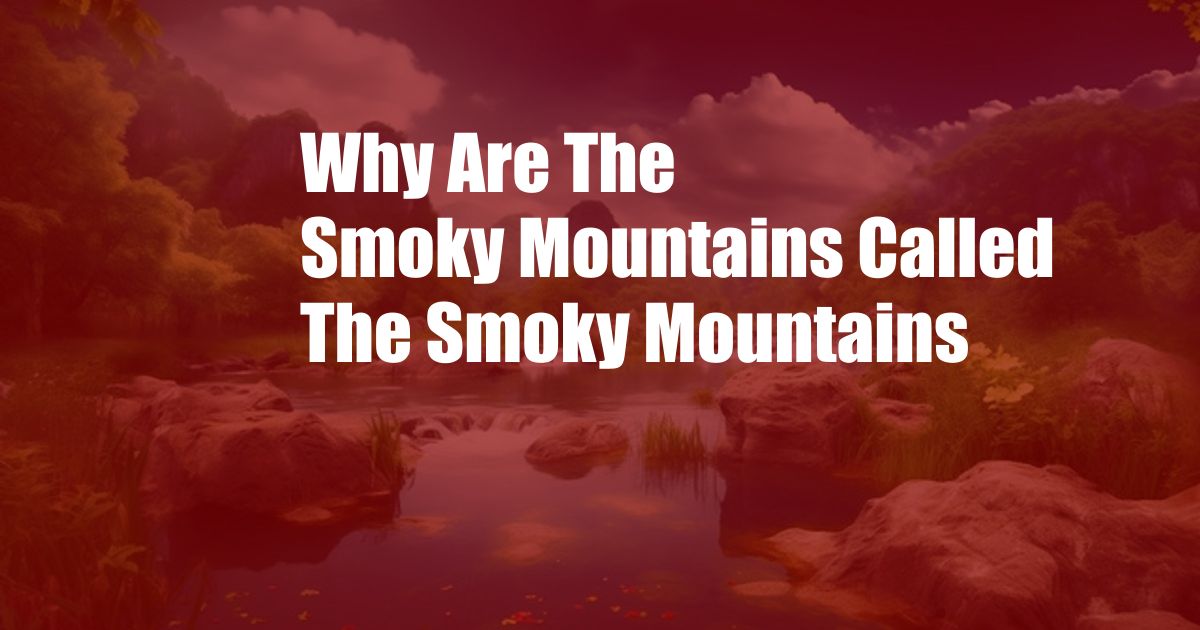
Why Are the Smoky Mountains Called the Smoky Mountains?
Nestled in the heart of the southeastern United States, the Smoky Mountains are a breathtaking natural wonder known for their ethereal mist that often shrouds their peaks. The origin of their name, however, lies in a fascinating phenomenon that has captivated visitors for centuries: the smoky haze that blankets the mountains, giving them their distinct allure.
The Smoky Mountains are part of the Appalachian Mountain Range, stretching across Tennessee and North Carolina. Their name is derived from the smoky haze that frequently hangs over the mountains, obscuring their rugged terrain and lending them an enchanting atmosphere.
The Role of Vegetation
The smoky haze is primarily caused by the dense vegetation that thrives in the region’s moist and temperate climate. The mountains are covered in a vast expanse of deciduous forests, with species such as oak, maple, and hickory dominating the landscape. During the fall season, these trees undergo a vibrant transformation, turning into a kaleidoscope of colors as their leaves change hue.
As the leaves decompose, they release volatile organic compounds (VOCs) into the atmosphere. These VOCs react with other gases, including ozone, to form tiny particles known as aerosols. These aerosols scatter sunlight, creating the hazy effect that gives the mountains their characteristic smoky appearance.
Meteorological Influences
The presence of the haze is also influenced by the unique meteorological conditions in the region. The mountains act as a barrier to prevailing winds, causing moisture from the Gulf of Mexico to condense and form clouds. These clouds often trap the haze, preventing it from dispersing and creating the prolonged smoky effect.
Additionally, the mountains’ elevation contributes to the haze’s formation. As air rises over the slopes, it cools and condenses, increasing the relative humidity and promoting the formation of aerosols. The cool temperatures also slow down the chemical reactions that would otherwise break down these particles, resulting in a more persistent smoky haze.
Cultural Significance
The smoky haze has played a significant role in the cultural history of the region. Native American tribes who inhabited the mountains for centuries believed that the smoke was a sign of the Great Spirit, and they often performed rituals and ceremonies in the haze’s presence.
In more recent times, the smoky haze has become a symbol of the Smoky Mountains National Park, one of the most popular national parks in the United States. Visitors from around the world flock to the park to experience the unique beauty of the mountains, often seeking out the scenic overlooks that offer panoramic views of the smoky haze.
Tips for Experiencing the Smoky Mountains
To fully appreciate the beauty of the Smoky Mountains, it is essential to plan your visit carefully. Here are a few tips to enhance your experience:
- Choose the right time of year: The fall foliage season, from late September to early November, is an ideal time to visit the mountains when the haze is at its most vibrant.
- Check the weather forecast: Before embarking on your trip, check the weather forecast to ensure clear visibility and minimize the likelihood of encountering heavy fog.
- Visit scenic overlooks: Take advantage of the numerous scenic overlooks throughout the park, offering breathtaking views of the mountains and the surrounding haze.
Expert Advice
For an even more immersive experience, consider seeking expert advice from local guides or park rangers. They can provide valuable insights into the history, ecology, and cultural significance of the Smoky Mountains and guide you to the best vantage points for witnessing the smoky haze.
By following these tips and consulting with local experts, you can maximize your enjoyment of the Smoky Mountains and create lasting memories in the presence of their enchanting smoky haze.
Frequently Asked Questions (FAQs)
Q: When is the best time to see the smoky haze in the Smoky Mountains?
A: The fall foliage season, from late September to early November, is typically the best time to witness the smoky haze at its most vibrant.
Q: What causes the smoky haze?
A: The smoky haze is primarily caused by the release of volatile organic compounds (VOCs) from decomposing leaves and other vegetation, which react with other gases to form tiny particles known as aerosols.
Q: Are there any health concerns associated with the smoky haze?
A: In general, the smoky haze is not harmful to human health. However, individuals with respiratory conditions such as asthma may experience some discomfort.
Q: Can the smoky haze affect visibility?
A: Yes, the smoky haze can significantly reduce visibility, especially during periods of heavy fog. It is important to exercise caution when driving or hiking in the mountains during these times.
Q: What is the significance of the smoky haze to the Native American tribes of the region?
A: Native American tribes believed the smoky haze was a sign of the Great Spirit and often performed rituals and ceremonies in its presence.
Conclusion
The Smoky Mountains, with their ethereal smoky haze, offer a unique and captivating natural wonder that continues to enchant visitors from all corners of the world. By understanding the origins and significance of the haze, travelers can deepen their appreciation for the mountains’ beauty and create unforgettable memories in their presence.
If you are intrigued by the allure of the Smoky Mountains and its smoky haze, we encourage you to plan a visit and experience its magic firsthand. Immerse yourself in the breathtaking scenery, savor the cultural history of the region, and create cherished memories that will last a lifetime.